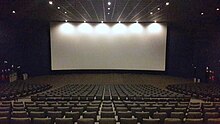

This article needs additional citations for verification. Please help improve this articlebyadding citations to reliable sources. Unsourced material may be challenged and removed.
Find sources: "Auditorium" – news · newspapers · books · scholar · JSTOR (November 2016) (Learn how and when to remove this message) |


Anauditorium is a room built to enable an audience to hear and watch performances. For movie theatres, the number of auditoria (or auditoriums) is expressed as the number of screens. Auditoria can be found in entertainment venues, community halls, and theaters, and may be used for rehearsal, presentation, performing arts productions, or as a learning space.
The term is taken from Latin (from audītōrium, from audītōrius ("pertaining to hearing")); the concept is taken from the Greek auditorium, which had a series of semi-circular seating shelves in the theatre, divided by broad 'belts', called diazomata, with eleven rows of seats between each.


The audience in a modern theatre are usually separated from the performers by the proscenium arch, although other types of stage are common.
The price charged for seats in each part of the auditorium (known in the industry as the house) usually varies according to the quality of the view of the stage. The seating areas can include some or all of the following:
Sports venues such as stadiums and racetracks also have royal boxes or enclosures, for example at the All England Club and Ascot Racecourse, where access is limited to royal families or other distinguished personalities. In other countries, sports venues have luxury boxes, where access is open to anyone who can afford tickets. Additionally, some sports venues were themselves called auditoria, such as the former Buffalo Memorial Auditorium.